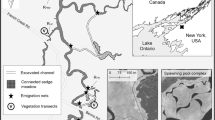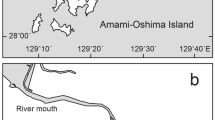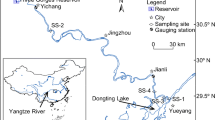Abstract
Context
Hydrological and land use changes for human purposes, have resulted in the increased fragmentation of river landscapes and the loss of aquatic habitats, leading to profound changes in fish diversity and productivity.
Objectives
In the fluvial Lake Saint-Pierre (St. Lawrence River, Canada), we studied how agricultural practices and water-flow regulation have impacted the area and connectivity of spawning habitats of northern pike (Esox lucius).
Methods
Northern pike spawning and nursery habitats were modelled over a 49-year period (1965–2013) to estimate effective spawning area under four contrasting hydrological conditions.
Results
Simulations coupled with land cover analyses revealed that natural flow conditions historically favourable for fish reproduction (high and stable water flows) have been lost due to human activities. The highest potential for reproduction and habitat connectivity have been lost due to (1) intensive agriculture and ploughing of natural vegetation in the upper floodplain that overlaps suitable spawning areas for northern pike, and (2) flow regulation that has lowered and shortened spring floods and dried spawning grounds more frequently.
Conclusions
To restore the St. Lawrence River functions, we propose to reconvert the portion of the floodplains that is vital to fish, but is currently used by intensive agriculture, into natural wetlands or perennial crops and to restore a more natural flow regime by extending the duration of floods between spawning and nursery periods. The highest priority for habitat restoration should target the most effective and recurrent spawning habitats, ditch and stream networks, and connected managed wetlands.







Similar content being viewed by others
References
Adriaensen F, Chardon JP, De Blust G, Swinnen E, Villalba S, Gulinck H, Matthysen E (2003) The application of ‘least-cost’ modelling as a functional landscape model. Landsc Urban Plan 64(4):233–247
Baber MJ, Childers DL, Babbitt KJ, Anderson DH (2002) Controls on fish distribution and abundance in temporary wetlands. Can J Fish Aquat Sci 59(9):1441–1450
Bayler PB (1991) The flood pulse advantage and the restoration of river-floodplain systems. Regulat Rivers Res Manag 6:75–86
Beesley L, King AJ, Gawne B, Koehn JD, Price A, Nielsen D, Amtstaetter F, Meredith SN (2014) Optimising environmental watering of floodplain wetlands for fish. Freshw Biol 59:2024–2037
Beier P, Noss R (1998) Do habitat corridors provide connectivity? Conserv Biol 12:1241–1252
Bishop-Taylor R, Tulbure MG, Broich M (2015) Surface water network structure, landscape resistance to movement and flooding vital for maintaining ecological connectivity across Australia’s largest river basin. Landsc Ecol 30:2045–2065
Blanton P, Marcus WA (2014) Roads, railroads, and floodplain fragmentation due to transportation infrastructure along rivers. Ann Assoc Am Geogr 104:413–431
Boyer C, Chaumont D, Chartier I, Roy AG (2010) Impact of climate change on the hydrology of St. Lawrence tributaries. J Hydrol 384(1–2):65–83
Boët P, Belliard J, Berrebi-dit-Thomas R, Tales E (1999) Multiple human impacts by the City of Paris on fish communities in the Seine river basin, France. Hydrobiologia 410:59–68
Brodeur P, Mingelbier M, Morin J (2004) Impacts des variations hydrologiques sur les poissons des marais aménagés du Saint-Laurent fluvial. Le Naturaliste Canadien 128(2):66–77
Brodeur P, Mingelbier M, Morin J (2006) Impact de la régularisation du débit des Grands Lacs sur l’habitat de reproduction des poissons dans la plaine inondable du fleuve Saint-Laurent. Le Naturaliste Canadien 130:60–68
Brodeur P, Simard A, Théberge M, Bacon R (2016) Suivi du segment 8 du complexe d’aménagement de Baie-du-Febvre / Nicolet Sud Bilan des activités 2009–2014. Direction de la gestion de la faune de la Mauricie et du Centre-du-Québec, Ministère des Forêts de la Faune et des Parcs, Trois-Rivières, p 69
Caldwell IR, Gergel SE (2013) Thresholds in seascape connectivity: influence of mobility, habitat distribution, and current strength on fish movement. Landsc Ecol 28(10):1937–1948
Carpentier A (2003) La régularisation du Saint-Laurent. Le Naturaliste Canadien 127:102–113
Casselman JM (1978) Effects of environmental factors on growth, survival, activity, and exploitation of northern pike. Am Fish Soc Spec Publ 11:114–128
Casselman JM, Lewis CA (1996) Habitat requirements of northern pike (Esox lucius). Can J Fish Aquat Sci 53:161–174
Centre Saint-Laurent (1998) Le fleuve en bref: capsules-éclair sur l'état du Saint-Laurent. Environnement Canada, Région du Québec: Saint-Laurent Vision 2000, Québec, p 121
de la Chenelière V, Brodeur P, Mingelbier M (2014) Restauration des habitats du lac Saint-Pierre: un prérequis au rétablissement de la perchaude. Le Naturaliste Canadien 138:50–61
Douven W, Buurman J, Beevers L, Verheij H, Goichot M, Nguyen NA, Truong HT, Ngoc HM (2012) Resistance versus resilience approaches in road planning and design in delta areas: Mekong floodplains in Cambodia and Vietnam. J Environ Plan Manag 55:1289–1310
Doyle MW, Stanley EH, Havlick DG, Kaiser MJ, Steinbach G, Graf WL, Galloway GE, Riggsbee JA (2008) Aging infrastructure and ecosystem restoration. Science 319:286–287
ECCC and MDDELCC (2018) Land cover mapping of the St. Lawrence Lowlands, circa (2014) Environment and Climate Change Canada and Ministère du Développement durable, de l’Environnement et de la Lutte contre les changements climatiques. St. Lawrence Action Plan, Québec, p 49
Farrell JM, Murry BA, Leopold DJ, Halpern A, Beland Rippke M, Godwin KS, Hafner SD (2010) Water-level regulation and coastal wetland vegetation in the upper St. Lawrence River: inferences from historical aerial imagery, seed banks, and Typha dynamics. Hydrobiologia 647:127–144
Fecteau M, Poissant L (2001) Survol des impacts environnementaux potentiels liés à la production de maïs à des fins énergétiques au Québec. Environnement Canada, Saint-Laurent Vision 2000, Montréal, p 78
Fernandes I, Penha J, Zuanon J (2015) Size-dependent response of tropical wetland fish communities to changes in vegetation cover and habitat connectivity. Landsc Ecol 30:1421–1434
Fortin P, Martin S, Plante A (2002) Post-traitement, validation et intégration des données LIDAR dans le modèle numérique de terrain du fleuve Saint-Laurent. Rapport technique SMC Québec-Section Hydrologie RT-120, Environnement Canada, Sainte-Foy, préparé par le Groupe en Besoin de Données Communes du Groupe d'étude international sur le lac Ontario et le fleuve Saint-Laurent (Commission mixte internationale), pp 30 + annexes
Foubert A, Le-Pichon C, Mingelbier M, Farrell JM, Morin J, Lecomte F (2018) Modeling the effective spawning and nursery habitats of northern pike within a large spatiotemporally variable river landscape (St. Lawrence River, Canada). Limnol Oceanogr 64(2):803–819
Gagliardi B, Pettigrove V (2013) Removal of intensive agriculture from the landscape improves aquatic ecosystem health. Agric Ecosyst Environ 176:1–8
Gorski K, De Leeuw JJ, Winter HV, Vekhov DA, Minin AE, Buijse AD, Nagelkerke LAJ (2011) Fish recruitment in a large, temperate floodplain: the importance of annual flooding, temperature and habitat complexity. Freshw Biol 56(11):2210–2225
Goto D, Hamel MJ, Hammen JJ, Rugg ML, Pegg MA, Forbes VE (2015) Spatiotemporal variation in flow-dependent recruitment of long-lived riverine fish: Model development and evaluation. Ecol Model 296:79–92
Hanke MH, Lambert JD, Smith KJ (2013) Utilization of a multicriteria least cost path model in an aquatic environment. Int J Geogr Inf Sci 28(8):1642–1657
Holland LE, Huston ML (1984) Relationship of young-of-the-year northern pike to aquatic vegetation types in backwaters of the upper Mississippi River. N Am J Fish Manag 4:514–522
Ishiyama N, Akasaka T, Nakamura F (2014) Mobility-dependent response of aquatic animal species richness to a wetland network in an agricultural landscape. Aquat Sci 76(3):437–449
Jeffres C, Moyle P (2012) When good fish make bad decisions: Coho Salmon in an ecological trap. N Am J Fish Manag 32(1):87–92
Johnson FH (1957) Northern pike year-class strength and spring water levels. Trans Am Fish Soc 86:285–293
Junk WJ, Bayley PB, Sparks RE (1989) The flood pulse concept in river-floodplain systems. Can. Spec. Publ. Fish. Aquat. Sci. 12:110–127
Le Pichon C, Gorges G, Boët P, Baudry J, Goreaud F, Faure T (2006a) A spatially explicit resource-based approach for managing stream fishes in riverscapes. Environ Manag 37(3):322–335
Le Pichon C, Gorges G, Faure T, Boussard H (2006b) Anaqualand 2.0: freeware of distances calculations with frictions on a corridor. Cemagref, Antony. https://www6.rennes.inra.fr/sad/Outils-Produits/Outils-informatiques/Anaqualand. Accessed 30 Mar 2020
Le Pichon C, Mingelbier M, Legros M, Foubert A, Brodeur P (2018) Effets du réseau routier sur la connectivité des frayères du grand brochet (Esox lucius) au lac Saint-Pierre (fleuve Saint-Laurent, Canada). Le Naturaliste Canadien 142:78–91
Martin J, Létourneau G (2011) Changements dans les milieux humides du fleuve Saint-Laurent de 1970 à 2002. Environnement Canada, Direction générale des sciences et de la technologie, Monitoring et surveillance de la qualité de l'eau au Québec, Rapport technique numéro 511, p 302
Matsuzaki S-IS, Terui A, Kodama K, Tada M, Yoshida T, Washitani I (2011) Influence of connectivity, habitat quality and invasive species on egg and larval distributions and local abundance of crucian carp in Japanese agricultural landscapes. Biol Conserv 144(8):2081–2087
Miehls SM, Dettmers JM (2011) Factors influencing habitat shifts of age-0 yellow perch in Southwestern Lake Michigan. Trans Am Fish Soc 140(5):1317–1329
Mingelbier M, Brodeur P, Morin J (2008) Spatially explicit model predicting the spawning habitat and early stage mortality of Northern pike (Esox lucius) in a large system: the St. Lawrence River between 1960 and 2000. Hydrobiologia 601(1):55–69
Mingelbier M, Douguet T (1999) Répertoire-synthèse des aménagements fauniques de la plaine inondable du lac Saint-Pierre. Direction de la faune et des habitats, Société de la faune et des parcs du Québec, p 37
Morin J, Champoux O, Martin S, Turgeon K (2005) Modélisation intégrée de la réponse de l’écosystème dans le fleuve Saint-Laurent: Rapport final des activités entreprises dans le cadre du Plan d’étude sur la régularisation du lac Ontario et du fleuve Saint-Laurent Rapport scientifique - RS-108. SMC-Hydrologie, Environnement Canada, Québec, p 139
Morin J, Leclerc M, Secretan Y, Boudreau P (2000) Integrated two-dimensional macrophytes-hydrodynamic modeling. J Hydraul Res 38:163–172
Morin J, Mingelbier M, Bechara JA, Champoux O, Secretan Y, Martin J, Frenette JJ (2003) Emergence of new explanatory variables for 2D habitat modelling in large rivers: The St. Canadian Water Resources Journal, Lawrence Experience, p 28
Morin J, Bouchard A (2000) Les bases de la modélisation du tronçon Montréal / Trois-Rivières. Rapport scientifique SMC-Hydrométrie RS-100. Environnement Canada, p 56
Mortsch L, Hengeveld H, Lister M, Lofgren B, Quinn F, Slivitky M, Wenger L (2000) Climate change impacts on the hydrology of the great lakes—St. Lawrence. Syst Can Water Ressour J 25(2):153–179
Nilsson C, Reidy CA, Dynesius M, Revenga C (2005) Fragmentation and flow regulation of the world's large river systems. Science 308:405–408
Ospina-Alvarez A, Parada C, Palomera I (2012) Vertical migration effects on the dispersion and recruitment of European anchovy larvae: from spawning to nursery areas. Ecol Model 231:65–79
Peake S (2004) Effect of approach velocity on impingement of juvenile northern pike at water intake screens. N Am J Fish Manag 24(2):390–396
Raat AJP (2001) Ecological rehabilitation of the Dutch part of the River Rhine with special attention to the fish. Regul Rivers Res Manag 17(2):131–144
Richard G, Côté D, Mingelbier M, Jobin B, Morin J, Brodeur P (2011) Utilisation du sol dans la plaine inondable du lac Saint-Pierre (fleuve Saint-Laurent) durant les périodes 1950, 1964 et 1997: interprétation de photos aériennes, numérisation et préparation d’une base de données géoréférencées. Ministère des Ressources naturelles et de la Faune, Gouvernement du Québec, Québec, p 42
Roy M, Le Pichon C (2017) Modelling functional fish habitat connectivity in rivers: a case study for prioritizing restoration actions targeting brown trout. Aquat Conserv Mar Freshw Ecosyst 27:927–937
Schiemer F, Keckeis H, Kamler E (2003) The early life history stages of riverine fish: ecophysiological and environmental bottlenecks. Comp Biochem Physiol 133:439–449
Schiemer F, Keckeis H, Reckendorfer W, Winkler G (2001) The "inshore retention concept" and its significance for large rivers. River Systems 12(2–4):509–516
Sheaves M, Baker R, Nagelkerken I, Connolly RM (2014) True value of estuarine and coastal nurseries for fish: incorporating complexity and dynamics. Estuar Coasts 38(2):401–414
Smith BM, Farrell JM, Underwood HB, Smith SJ (2007) Year-class formation of upper St. Lawrence river northern pike. N Am J Fish Manag 27(2):481–491
Timm AL, Pierce RB (2015) Vegetative substrates used by larval northern pike in Rainy and Kabetogama Lakes. Minn Ecol Freshw Fish 24(2):225–233
Tockner K, Stanford JA (2002) Riverine flood plains: present state and future trends. Environ Conserv 29:3
Turgeon K, Morin J (2005) Modelling submerged macrophytes distribution: evaluation of models transferability in three St. Lawrence River sections scientific report MSC Québec –Hydrology Section RS-105. Environment Canada, Sainte-Foy, p 61
Van der Ree R, Jaeger JAG, Van der Grift EA, Clevenger AP (2011) Effects of roads and traffic on wildlife populations and landscape function: road ecology is moving towards larger scales. Ecol Soc 16(1):48
Volk XK, Gattringer JP, Otte A, Harvolk-Schoïning S (2018) Connectivity analysis as a tool for assessing restoration success. Landsc Ecol 33:371–387
Washitani I (2007) Restoration of biologically-diverse floodplain wetlands including paddy fields. Glob Environ Res 11:135–140
Wiens JA (2002) Riverine landscapes: taking landscape ecology into the water. Freshw Biol 47:501–515
Wohl E (2017) Connectivity in rivers. Prog Phys Geogr 41(3):345–362
Wohl E, Lane SN, Wilcox AC (2015) The science and practice of river restoration. Water Resour Res 51:5974–5997
Acknowledgements
This study would not have been possible without the contribution of John Farrell and the members of the Thousand Islands Biological Station for conducting field experiences and Sylvain Martin for kindly providing hydrological data. A special thank goes to Dr. Mathieu Cusson and Julian J. Dodson for revisions of earlier version of the manuscript. This study is part of A.F.’s Ph.D. thesis. Financial support was provided by grants from the “Chaire de Recherche sur les Espèces Aquatiques Exploitées”, the Ministère des Forêts, de la Faune et des Parcs du Québec (MFFP), the “Ressources Aquatiques Québec”, and the “Commission permanente de coopération franco-québécoise”.
Author information
Authors and Affiliations
Corresponding author
Additional information
Publisher's Note
Springer Nature remains neutral with regard to jurisdictional claims in published maps and institutional affiliations.
Contribution to the “Chaire de Recherche sur les Espèces Aquatiques Exploitées” 20 (CREAE).
Electronic supplementary material
Below is the link to the electronic supplementary material.
Rights and permissions
About this article
Cite this article
Foubert, A., Lecomte, F., Brodeur, P. et al. How intensive agricultural practices and flow regulation are threatening fish spawning habitats and their connectivity in the St. Lawrence River floodplain, Canada. Landscape Ecol 35, 1229–1247 (2020). https://doi.org/10.1007/s10980-020-00996-9
Received:
Accepted:
Published:
Issue Date:
DOI: https://doi.org/10.1007/s10980-020-00996-9




